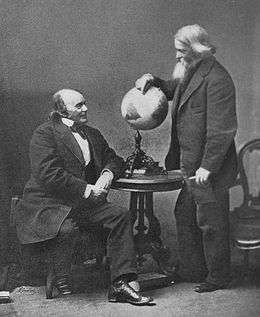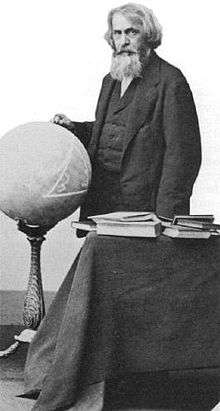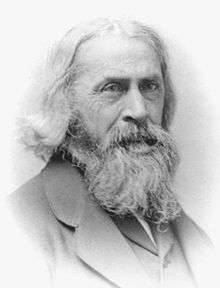Benjamin Peirce
| Benjamin Peirce | |
|---|---|
|
Benjamin Peirce | |
| Born |
4 April 1809 Salem, Massachusetts |
| Died |
6 October 1880 (aged 71) Cambridge, Massachusetts |
| Nationality | American |
| Fields |
Mathematics Statistics Science policy |
| Institutions |
Harvard University Superintendent of the United States Coast Survey |
| Alma mater | Harvard University |
| Academic advisors | Nathaniel Bowditch |
| Notable students | Joseph Lovering |
| Known for |
Peirce's criterion for outliers (statistics) Definition of mathematics as the science of necessary truths linear algebras celestial mechanics |
| Influenced | Charles Sanders Peirce |
Benjamin Peirce (/ˈpɜːrs/;[1] April 4, 1809 – October 6, 1880) was an American mathematician who taught at Harvard University for approximately 50 years. He made contributions to celestial mechanics, statistics, number theory, algebra, and the philosophy of mathematics.
He was the son of Benjamin Peirce (1778–1831), later librarian of Harvard, and Lydia Ropes Nichols Peirce (1781–1868).[2]
After graduating from Harvard, he remained as a tutor (1829), and was subsequently appointed professor of mathematics in 1831. He added astronomy to his portfolio in 1842, and remained as Harvard professor until his death. In addition, he was instrumental in the development of Harvard's science curriculum, served as the college librarian, and was director of the U.S. Coast Survey from 1867 to 1874.
Research
Benjamin Peirce is often regarded as the earliest American scientist whose research was recognized as world class.[3] He was an apologist for slavery opining that it should be condoned if it was used to allow an elite to pursue scientific enquiry.[4]
Mathematics
In number theory, he proved there is no odd perfect number with fewer than four prime factors.
In algebra, he was notable for the study of associative algebras. He first introduced the terms idempotent and nilpotent in 1870 to describe elements of these algebras, and he also introduced the Peirce decomposition.
Definition of mathematics
In the philosophy of mathematics, he became known for the statement that "Mathematics is the science that draws necessary conclusions".[5] Peirce's definition of mathematics was credited by his son, Charles Sanders Peirce, as helping to initiate the consequence-oriented philosophy of pragmatism.
Like George Boole, Peirce believed that mathematics could be used to study logic. These ideas were further developed by Charles Sanders Peirce, who noted that logic also includes the study of faulty reasoning.
In contrast, the later logicist program of Gottlob Frege and Bertrand Russell attempted to base mathematics on logic.
Statistics
Peirce proposed what came to be known as Peirce's Criterion for the statistical treatment of outliers, that is, of apparently extreme observations. His ideas were further developed by Charles Sanders Peirce.[6]
Peirce was an expert witness in the Howland will forgery trial, where he was assisted by his son Charles Sanders Peirce. Their analysis of the questioned signature showed that it resembled another particular handwriting example so closely that the chances of such a match were statistically extremely remote.
Private life

He was devoutly religious, though he seldom published his theological thoughts.[7] Peirce credited God as shaping nature in ways that account for the efficacy of pure mathematics in describing empirical phenomena.[8] Peirce viewed "mathematics as study of God's work by God's creatures", according to an encyclopedia.[7]
He married Sarah Hunt Mills, the daughter of U.S. Senator Elijah Hunt Mills.[9] Peirce and his wife had four sons and one daughter:[10]
- James Mills Peirce (1834–1906), who also taught mathematics at Harvard and succeeded to his father's professorship,
- Charles Sanders Peirce (1839–1914), a famous logician, polymath and philosopher,
- Benjamin Mills Peirce (1844–1870), who worked as a mining engineer before an early death,
- Helen Huntington Peirce Ellis (1845–1923), who married William Rogers Ellis, and
- Herbert Henry Davis Peirce (1849–1916), who pursued a career in the Foreign Service.

Eponyms
The lunar crater Peirce is named for Peirce.
Post-doctoral positions in Harvard University's mathematics department are named in his honor as Benjamin Peirce Fellows and Lecturers.
The United States Coast Survey ship USCS Benjamin Peirce, in commission from 1855 to 1868, was named for him.[11]
Works
- An Elementary Treatise on Plane and Spherical Trigonometry, Boston: James Munroe and Company. Google Eprints of successive editions 1840–1862.
- Physical and Celestial Mechanics, Boston: Little, Brown and Company. Google Eprint of 1855 edition.
- Linear Associative Algebra, lithograph by Peirce 1872. New edition with corrections, notes, and an added 1875 paper by Peirce, plus notes by his son Charles Sanders Peirce, published in the American Journal of Mathematics v. 4, 1881, Johns Hopkins University, pp. 221–226, Google Eprint and as an extract, D. Van Nostrand, 1882, Google Eprint.
- 1872: A System of Analytical Mechanics, David van Nostrand & Company, link from Internet Archive
See also
- Benjamin Osgood Peirce (1854–1914)
- Tachytrope, curve in which the law of the velocity is given. Developed by Pierce.
Notes
- ↑ "Peirce", in the case of Benjamin Peirce and family, always rhymes with "terse" and so, in most dialects, is pronounced like the word "
 purse ". See "Note on the Pronunciation of 'Peirce'", The Peirce [Edition] Project Newsletter, Vol. 1, Nos. 3/4, Dec. 1994, Eprint.
purse ". See "Note on the Pronunciation of 'Peirce'", The Peirce [Edition] Project Newsletter, Vol. 1, Nos. 3/4, Dec. 1994, Eprint. - ↑ Rossiter Johnson; John Howard Brown (1904). The twentieth century biographical dictionary of notable Americans ... The Biographical Society. pp. 269–. Retrieved 28 August 2011.
- ↑ Stigler, Stephen M. (1978). "Mathematical Statistics in the Early States". Annals of Statistics. 6 (2): 239–265. doi:10.1214/aos/1176344123. JSTOR 2958876.
- ↑ Auspitz, Josiah Lee (Autumn 1994). "The Wasp Leaves the Bottle: Charles Sanders Peirce". The American Scholar. 63 (4): 602–618.
- ↑ First line of Linear Associative Algebra
- ↑ Peirce, Charles Sanders (1870/1871/1873).
- 1 2 Grattan-Guinness, Ivor and Walsh, Alison (2008), "Benjamin Peirce", Stanford Encyclopedia of Philosophy. Eprint.
- ↑ Peirce, "Address of Professor Benjamin Peirce, President of the American Association for the Year 1853", Proceedings of the American Association for the Advancement of Sciences, Eighth Meeting [ = Volume 8], held at Washington D.C., May, 1854, published 1855, pp. 1–17, see especially pp. 12–15. Google Books Eprint
- ↑ Adams, Henry. The Life of George Cabot Lodge. pp. 4–5. Boston and New York: Houghton Mifflin, 1911
- ↑ Fisch, Max H. (1981), Introduction, Writings of Charles S. Peirce v. 1.
- ↑ noaa.gov NOAA Legacy: Tools of the Trade: Coast and Geodetic Survey Ships: Benjamin Peirce
References
- F. P. Matz, "B. O. Peirce: Biography," American Mathematical Monthly, 1895, № 2, 173–179. Google Eprint.
- S. R. Peterson, "Benjamin Peirce: Mathematician and Philosopher," Journal of the History of Ideas, 16, 1955, 89–112.
- P. Meier and S. Zaibel, "Benjamin Peirce and the Howland Will", Journal of the American Statistical Association, 75, 1980, 497–506.
- Peirce, Benjamin (1852), "Criterion for the Rejection of Doubtful Observations", Astronomical Journal II 45 and Errata to the original paper. Link pages for their non-PDF images of the article and its errata.
- Peirce, Benjamin (1872, 1881), Linear Associative Algebra. Lithograph edition by Peirce 1872. New edition with corrections, notes, and an added 1875 paper by Peirce, plus notes by his son Charles Sanders Peirce, published in the American Journal of Mathematics v. 4, n. 1, 1881, Johns Hopkins University, pp. 221–226, Google Eprint, doi:10.2307/2369153 JSTOR and as an extract, D. Van Nostrand, 1882, Google Eprint, Internet Archive Eprint.
- Peirce, Benjamin (1878), "On Peirce's Criterion", Proceedings of the American Academy of Arts and Sciences, v. 13 (whole series), v. 5 (new series), for May 1877 – May 1878, Boston: Press of John Wilson and Son, pp. 348–351. Google Eprint. JSTOR abstract.
- Peirce, Charles Sanders (1870/1871/1873) "Appendix No. 21. On the Theory of Errors of Observation", Report of the Superintendent of the United States Coast Survey Showing the Progress of the Survey During the Year 1870, pp. 200–224. Coast Survey Report submitted February 18, 1871, published 1873 by the U.S. Government Printing Office, Washington, D.C. Reports 1837–1965. NOAA PDF Eprint (link goes to 1870 Report's p. 200, PDF's p. 215). Reprinted in pp. 140–160 of Writings of Charles S. Peirce: A Chronological Edition: Volume 3, 1872–1878, Christian J. W. Kloesel et al., eds., Bloomington, Indiana: Indiana University Press, ISBN 0-253-37201-1.
- Stigler, Stephen M. (1980). "Mathematical Statistics in the Early States". In Stephen M. Stigler. American Contributions to Mathematical Statistics in the Nineteenth Century, Volumes I & II. I. New York: Arno Press.
- Stigler, Stephen M. (1989). "Mathematical Statistics in the Early States". In Peter Duren. A Century of Mathematics in America. III. Providence, RI: American Mathematical Society. pp. 537–564.
External links
| Wikiquote has quotations related to: Benjamin Peirce |
| Wikimedia Commons has media related to Benjamin Peirce. |
- Benjamin Peirce at the Mathematics Genealogy Project
- Benjamin Peirce at Find a Grave
- Grattan-Guinness, Ivor, and Walsh, Alison (2005), "Benjamin Peirce", Stanford Encyclopedia of Philosophy, Edward N. Zalta (ed.), Eprint.
- O'Connor, John J., and Robertson, Edmund F. (2005), "Benjamin Peirce", MacTutor History of Mathematics Archive, Eprint.
- Hogan, Edward R. (2008), Of the Human Heart: A Biography of Benjamin Peirce, Lehigh University Press, catalog page discussion of Peirce.
| Government offices | ||
|---|---|---|
| Preceded by Alexander Dallas Bache |
Superintendent, United States Coast Survey 1867–1874 |
Succeeded by Carlile Pollock Patterson |
